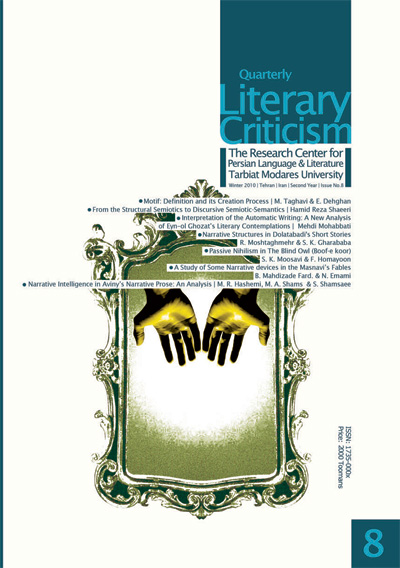Enter your email address
Submit









































2008-0360 :pISSN
2538-2179 :eISSN
| Aim and scope:
The main goal of the Quarterly is to focus on supporting critical thoughts and publishing literary studies with critical approaches. Therefore, emphasis is placed on publishing priority articles in order to develop critical thoughts in both areas of literary theory and practical critique; to provide theoretical knowledge and theoretical reflection in literary studies in Persian; a way to apply theories and methods of critique in Open patriotic literature; lead readers to recognize the theorizing capabilities of the patriotic literature and link the world of literary critique and Persian literature.
|
| Peer-Review Policy:
The review process for this Journal is double-blinded, meaning neither the reviewer knows the author's identity nor does the author know the reviewer's. Articles are assessed for both structure and relevance to the principles of Literary Criticism. They are then reviewed anonymously by three experts in the field (who are not part of the editorial team), selected by the Board according to their areas of expertise. The final decision on article acceptance is made by the Board.
|
| Open Access Policy: This Journal contents and the individual articles are freely available to readers without subscriptions or payments through the journal website or its permanent repositories. This open-access journal is published under the terms of the Creative Commons Attribution-NonCommercial 4.0 International License which permits Share (copy and redistribute the material in any medium or format) and Adapt (remix, transform, and build upon the material) under the Attribution-NonCommercial terms. |
| Licensing Policy :This Journal is licensed under the terms of the Creative Commons Attribution-NonCommercial "(CC BY-NC)" This license lets others remix, tweak, and build upon your work non-commercially, and although their new works must also acknowledge you and be non-commercial, they don’t have to license their derivative works on the same terms. View License Deed | View Legal Code |
| Publishing Ethics: This Journal follows all the terms and conditions of the Committee on Publication Ethics (COPE) and complies with the highest ethical standards in accordance with ethical laws. Authors may refer to the Committee on Publication Ethics’ International Standards for Authors for comprehensive information. |
| Authors fees : Dear authors/ paper contributors, you are being humbly informed that the journal charges 350 Thousand Tomans (In two steps: Reviewing: 150 Thousand Tomans and Publishing: 200 thousand Tomans) |
| To receive iThenticate certificate, refer to the SAMIM NOOR Site at: https://www.samimnoor.ir/view/fa/Default/%d8%b5%d9%81%d8%ad%d9%87-%d8%a7%d8%b5%d9%84%db%8c |
| Self-archiving policies for authors Authors are permitted to post their work online in institutional/disciplinary repositories or on their own websites. Pre-print versions posted online should include a citation and link to the final published version in this Journal as soon as the issue is available; post-print versions (including the final publisher's PDF) should include a citation and link to the journal's website |
| Copyright Policy : Under open access license, authors retain ownership of the copyright for their content, but allow anyone to download, reuse, and reprint, modify, distribute, and/or copy the content as long as the original authors and source are cited properly. |
| Agreement with the Iranian Academy of Literary Criticism |
ruhollah hadi, Sima Rahmanifar, mohammadreza torki, mitra golchin